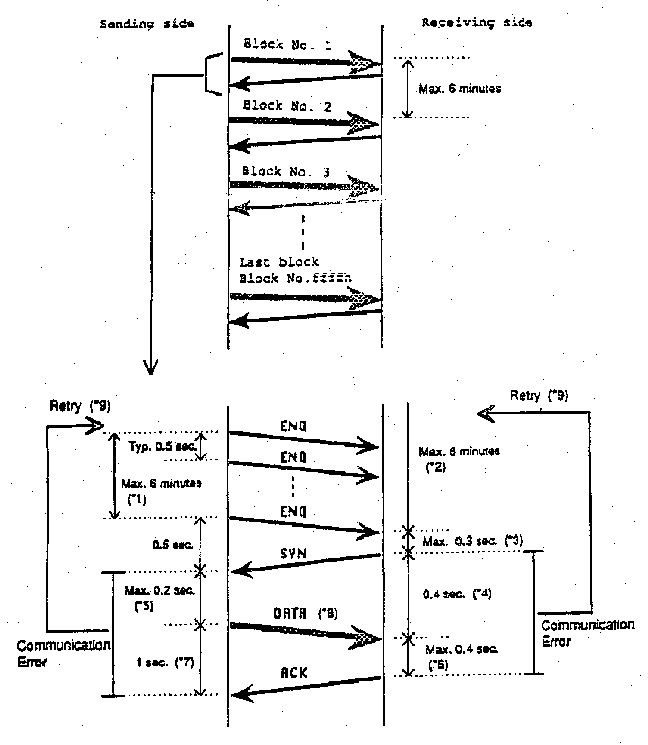Infrared Characteristics
Communications Specification
Packet Specifications
Protocol
| Transmission distance | less than 1 meter |
| Carrier | infrared 900 - 1050 nm peak |
| Subcarrier | 500KHz (450 - 550KHz) |
| Modulation | ASK |
| Baud Rate | 9600 bps |
| Data Length | 8 bits |
| Parity | Odd |
| Stop Bits | 1 |
| Field | Value | Length | Comments |
|---|---|---|---|
| Sync Dummy | 0x00 | 5 | Receivers wait for 0x00 0x00 0x96 |
| Start ID | 0x96 | 1 | |
| ID Code 1 | 0x81 or 0x91 | 1 | bits 7-4 are target equipment type, bits 3-0 are type of packet |
| Version Number | 0x10 | 1 | Only bits 7-4 should be checked by receiver |
| Block Number | 0x0001 - 0xffff | 2 | Last block always 0xffff (low/high) |
| Control Code | 0x01 | 1 | Not checked by receiver |
| Device Code | 0x40 | 1 | |
| ID Code 2 | 0xfe | 1 | |
| Data Length | 0x0000 - 0x0200 | 2 | If data is exactly 512 bytes, two packets are required, with 0 bytes in second packet. |
| Data | 0 - 512 | ||
| Check Sum | 2 | Check sum of data part (low/high) |
| Field | Value | Length | Comments |
|---|---|---|---|
| Sync Dummy | 0x00 | 5 | Receivers wait for 0x00 0x00 0x96 |
| Start ID | 0x96 | 1 | |
| ID Code 1 | 0x82 or 0x92 | 1 | bits 7-4 are target equipment type, bits 3-0 are type of packet |
| Control Data | 0x05 | 1 | ENQ - Request to send |
| 0x16 | SYN - Clear to send | ||
| 0x06 | ACK - Completion of receiving data | ||
| 0x15 | NAK - Failed to receive data | ||
| 0x18 | CAN - Interruption of receiving data |

Sending Side
Send ENQ every 0.5 seconds waiting for SYN for normally 6
minutes (in case of a retry process, 10 seconds). If CAN
is received or no answer is received, the sending side
aborts data transmission. If any other data is received,
the sending side moves to a retry process.
Receiving Side
Wait for ENQ for normally 6 minutes
(in case of a retry process, 10 seconds). If no ENQ is
received, the receiving side aborts data transmission.
Receiuing Side
SYN must be sent within 0.3 seconds after receiving
ENQ. If the receiving side wants to abort data
transmission, it should send CAn instead of SYN.
Receiving Side
If no Data packet is received within 0.4 seconds after
sending SYNs the receiving side moves to a retry
process.
Sending Side
Sending side must start sending Data packet within 0.2
seconds after receiving SYN.
Receiving Side
ACK must be sent within 0.4 seconds after receiving the
last byte of the Data packet.
Sending side
If ACK is not received within 1 second or other
data (including NACK) is received, the sending
side moves to a retry process.
Sending side
The sending side must finish sending one Data packet
within 4 seconds.
Receiving side
If the last byte of the Data packet is not received
within 5 seconds after receiving the first byte of the
packet, the receiving side moves to a retry
process. If a communication error is detected, the
receiving side must skip all received data until:
In case of a checksum error, send NACK within 0.4 seconds and move to a retry process ...
Sending and Receiving side
If a communication error occurs, both sides try to
transfer the same block again (retry process). The
sending side backs to the stage of sending ENQ, the
receiving side backs to the stage of receiving ENQ. In
this case, the time-out (6 minutes) is reduced to 10
seconds. Retry process must be performed within 1
second after the communication error is
confirmed. Retry process can be done up to 2 times (3
times in total).
Continuous two bytes in one packet must be sent within 0.2 seconds, If continuous two bytes are not received within 0.4 seconds the receive side should detect a communications error.
Switching from send mode to receive mode must be done within 2 milliseconds.. In other words, equipment must be ready for receiving data within 2 milliseconds after sending the last byte. No data must be sent within 3 milliseconds after receiving the last byte.
Each packet (both Data and Control) is considered to start when continuous 3 bytes (OOh, OOh, 96h) are detected. Other data are ignored before detecting these continuous 3 bytes.
If a non-sequential block number (i.e., a value other than the last block number received + 1 or OFFFFh) is received in the Block No. field, the receiving side should detect an error and start a retry process. It is also the sam case when the same Block No. as the previous one is received (this will happen if the sending side cannot receive ACK from the receiving side).